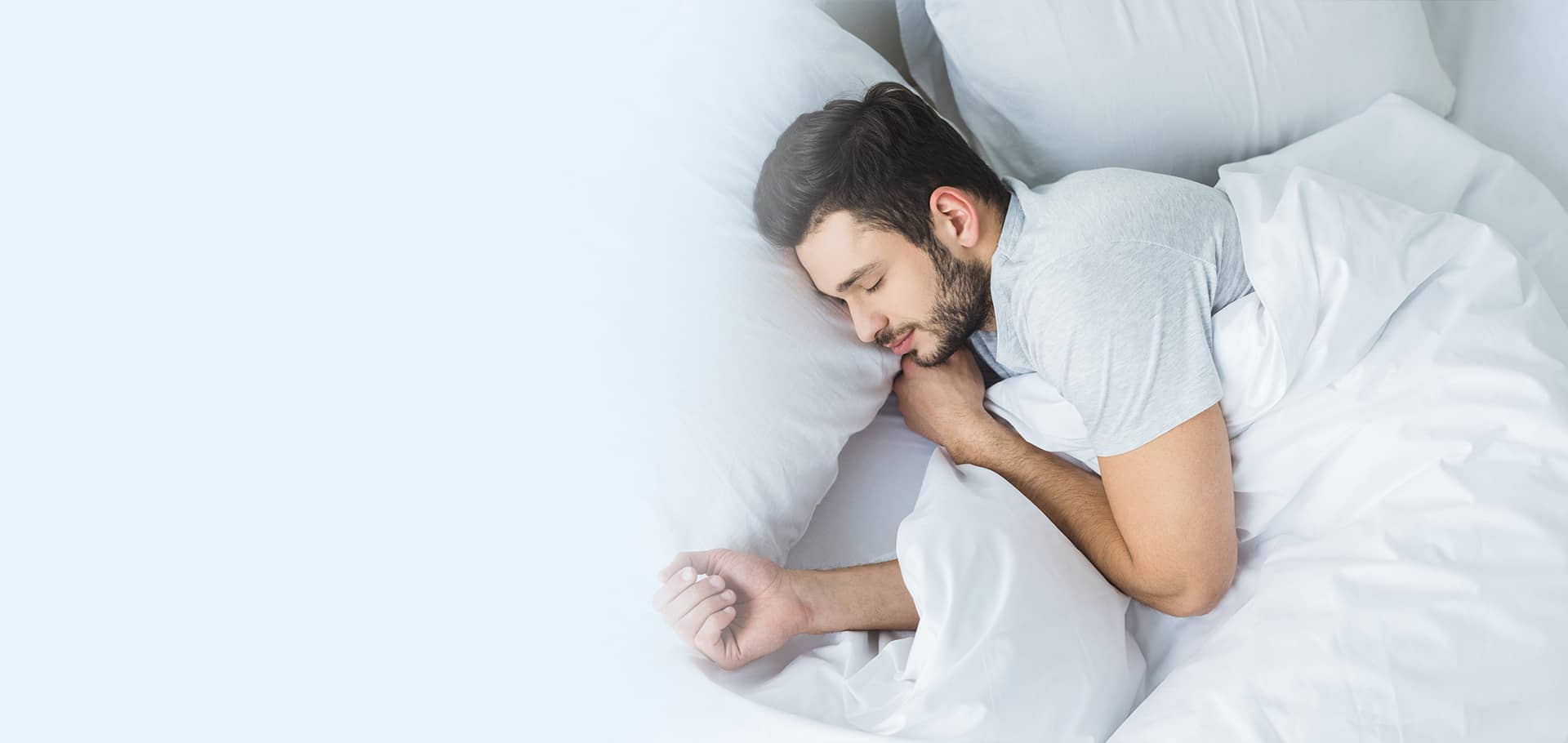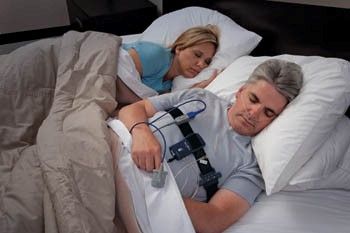
Sleep Apnea Treatment
Sleep apnea is a serious sleep disorder that affects millions of Americans. If left untreated, it can cause long-term medical complications such as high blood pressure, stroke, or heart failure. Fortunately, Penn Medicine Becker ENT & Allergy and our highly-trained team of ENT doctors are here to help those suffering from this potentially life-threatening condition. Our specialists assess the severity of your sleep apnea, develop a personalized treatment plan and provide the best care available so you can get back to living your best life!
What is Sleep Apnea?
Sleep apnea is a chronic medical condition that can significantly impact an individual’s quality of life. It affects people of all ages, including children and adults. Sleep apnea has two main types, namely obstructive sleep apnea (OSA) which is is more prevalent, and central sleep apnea (CSA) which is less common and typically associated with underlying medical conditions.

Types of Sleep Apnea
Obstructive Sleep Apnea (OSA)
Central Sleep Apnea (CSA)
Obstructive sleep apnea is the most common type of sleep apnea. It occurs when the muscles in the back of the throat fail to keep the airway open, leading to repetitive breathing pauses during sleep. Individuals suffering from sleep apnea commonly encounter symptoms such as loud snoring, episodes of gasping for air, and disrupted sleep patterns.
Central sleep apnea is caused by a failure of the brain to transmit proper signals to the muscles that control breathing. Unlike OSA, it is not related to physical obstruction of the airway. CSA is often associated with underlying medical conditions such as heart disease, stroke, or neurological disorders.
Symptoms of Sleep Apnea
Sleep apnea can manifest through various symptoms, including:
- Loud and chronic snoring
- Frequent awakenings during the night
- Daytime sleepiness and fatigue
- Morning headaches
- Difficulty concentrating and memory problems
- Irritability and mood swings
Risk Factors and Causes
Several factors contribute to the development of sleep apnea. These include:
- Excess Weight: Being overweight or obese increases the risk of sleep apnea due to the presence of excess tissue in the throat and neck area, which can obstruct the airway.
- Family History: People with a family history of sleep apnea are more likely to develop the condition.
- Age: While sleep apnea can manifest at any stage of life, it is more frequently observed among middle-aged and elderly individuals.
- Gender: Men are more prone to developing sleep apnea than women.
- Medical Conditions: Certain health conditions, such as heart disease and type 2 diabetes, increase the risk of sleep apnea.
Diagnosis and Sleep Study
To diagnose sleep apnea, a sleep specialist may recommend a sleep study, also known as a polysomnography. During this test, various parameters such as breathing patterns, brain activity, heart rate, and blood oxygen levels are monitored while the individual sleeps. The results help determine the severity of sleep apnea and guide the treatment plan. In most cases, the sleep study can be performed at home with a device ordered by your physician and mailed to your home.

Common Treatments for Sleep Apnea
Several effective treatments are available for managing sleep apnea. The choice of treatment depends on the severity of the condition and the specific needs of the individual. Some common treatment options include:
- Continuous Positive Airway Pressure (CPAP): CPAP therapy involves wearing a mask over the nose or mouth during sleep, which delivers a continuous flow of air to keep the airway open.
- Oral Appliance Therapy: Custom-made oral appliances can help reposition the jaw and tongue, preventing airway obstruction during sleep.
- Lifestyle Modifications: Certain lifestyle changes, such as weight loss, regular exercise, and avoiding alcohol and sedatives, can improve sleep apnea symptoms.
- Surgery: In severe cases or when other treatments fail, surgical intervention may be necessary to remove excess tissue or correct structural abnormalities in the airway.
Schedule your consultation
Select Surgeries and Procedural Treatment for Sleep Apnea
Pillar Procedure
The Pillar Procedure is a minimally invasive treatment for mild to moderate OSA involving small implants in the soft palate. It’s performed in-office under local anesthesia and has minimal downtime. Studies support its effectiveness for selected OSA patients.
Tonsillectomy
Hypertrophy of the tonsils obstructs the oral airway and contributes to sleep apnea. Tonsillectomy may be necessary if it’s a significant obstruction source. Techniques to remove them vary and must be discussed with a surgeon.
Uvula Treatments
An enlarged uvula may cause snoring or OSA and can be surgically removed. It’s usually done with other procedures, like Pillar or tonsillectomy, as it alone may not solve the problem.
UvulaPalatoPharyngoPlasty (UPPP)
The traditional UPPP surgery involves removing the uvula, tonsils, and part of the soft palate to open up the airway. Although it offers varying success rates, it’s associated with significant pain and long recovery times. Nevertheless, it may be a good choice for some patients.
Tongue Base Treatment
In some OSA patients, an enlarged tongue base obstructs the airway. Treatments include Midline glossectomy and Radiofrequency ablation (RFA). Midline glossectomy is less common due to post-op complications. RFA can have mixed results and may require multiple treatments over weeks to months.
Genioglossus Advancement
The genioglossus muscle can cause OSA when relaxed. It can be advanced forward via surgery to create more space in the oral cavity and oropharynx. Genoglossus Advancement is usually done with other procedures and has varying success rates.
Hyoid treatment
Re-positioning the hyoid bone may treat SDB and OSA if it’s located backward. Hyoid suspension is combined with other techniques since it’s not a stand-alone surgery. The hyoid bone is horseshoe-shaped and is the only bone that’s not connected to another bone.
Inspire Treatment
Inspire therapy involves implanting an FDA-cleared neuro-stimulation device for patients with moderate to severe OSA who can’t use CPAP. As an alternative to CPAP, the device is implanted via 3 small incisions, typically as an outpatient procedure, and reduces apneic events per hour by over 75%. Before undergoing Inspire therapy, patients undergo a rigorous pre-procedure evaluation.
OSA patients have many treatment options, from weight loss and CPAP use to surgeries. Consult with your doctor to choose the best option for managing your OSA. Our telemedicine doctor is available to help.
Adopting Lifestyle Adjustments to Address Sleep Apnea
Sleep position, air pressure, and blood pressure all play an important role in managing sleep apnea. For instance, sleeping on your side can help open up the airways and reduce the risk of breathing pauses. Additionally, using a Continuous Positive Airway Pressure (CPAP) machine during sleep can help maintain adequate air pressure in the throat and keep it open. Finally, medications such as beta-blockers may be prescribed to control high blood pressure, which can worsen symptoms of sleep apnea.
In addition to the specific treatments mentioned above, making certain lifestyle changes can significantly improve sleep apnea symptoms and overall sleep quality. These changes may include:
- Maintaining a healthy weight through a balanced diet and regular exercise.
- Avoiding alcohol and sedatives, as they can relax the muscles in the throat and exacerbate sleep apnea symptoms.
- Practicing positional therapy by sleeping on the side instead of the back, as this can help keep the airway open.
- Managing nasal congestion and allergies as they can contribute to breathing difficulties during sleep.

Pick one of our convenient locations
for your Sleep Apnea Treatment
